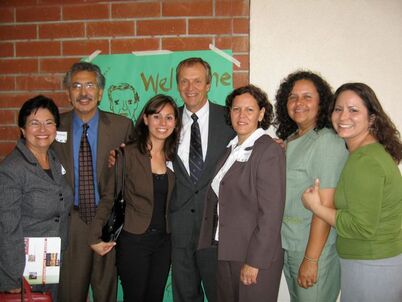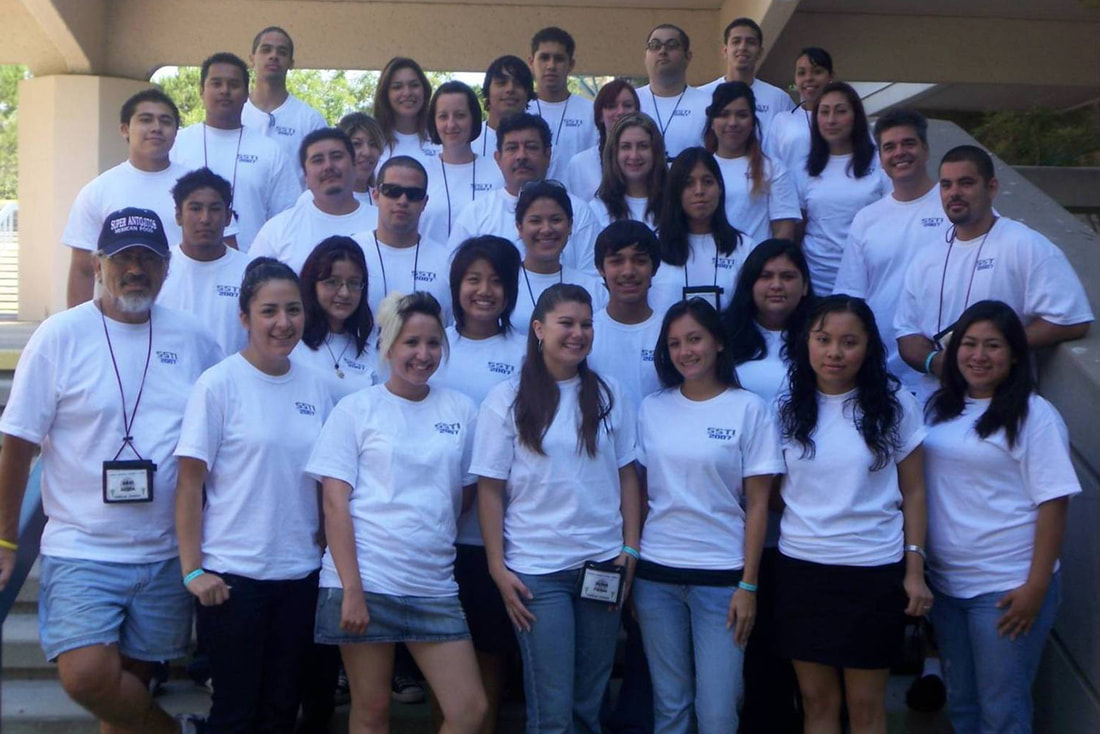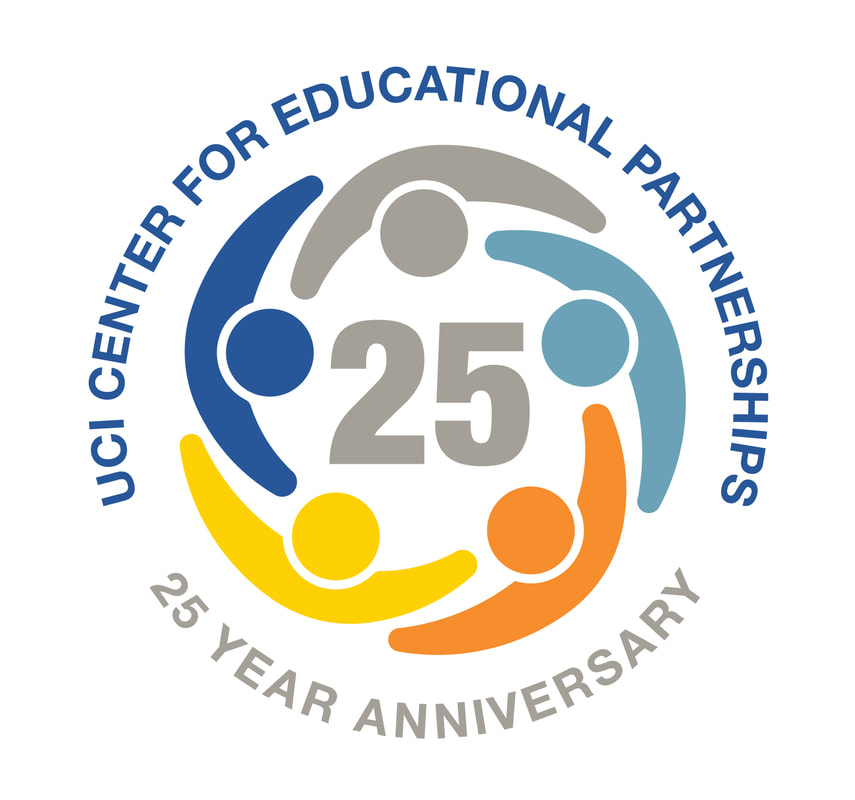THE PARTNERSHIP BLUEPRINT
The partnership was a novel concept at the time of its creation for a few reasons. First, it connected UCI professors directly with teachers at SAUSD schools and fostered a two-way learning relationship. At the time, many university outreach programs either simply distributed information about college – such as financial aid, or application and graduation requirements – or sent professors to study K-12 classrooms and learn from the environments.
“We began a new concept of connecting UCI faculty with entire, specific schools,” said Manuel Gómez, former vice chancellor, student affairs. “This represented a major shift from information distribution models to academic, faculty-led preparatory models.”
Dennis Galligani – who from 1982-90 served as assistant vice chancellor, academic affairs for UCI – recalls the epiphany that sparked the creation of the partnership.
At the closing ceremony of an on-campus summer program for Santa Ana students, Galligani walked alongside Gómez in Aldrich Park. Gómez said the summer program was wonderful, but was only a short touch with students. The real issue, he said, was that they were returning to the classroom, and would lose their connection to UCI, the campus and its faculty.
“We began a new concept of connecting UCI faculty with entire, specific schools,” said Manuel Gómez, former vice chancellor, student affairs. “This represented a major shift from information distribution models to academic, faculty-led preparatory models.”
Dennis Galligani – who from 1982-90 served as assistant vice chancellor, academic affairs for UCI – recalls the epiphany that sparked the creation of the partnership.
At the closing ceremony of an on-campus summer program for Santa Ana students, Galligani walked alongside Gómez in Aldrich Park. Gómez said the summer program was wonderful, but was only a short touch with students. The real issue, he said, was that they were returning to the classroom, and would lose their connection to UCI, the campus and its faculty.
|
The next week, Galligani and Gómez scheduled a meeting with the SAUSD superintendent, who agreed to let UCI faculty work with the SAUSD teachers. From there, Galligani said, the partnership “grew and grew.”
“Right from the start we tried to make sure it was a two-way street: UCI faculty learning from K-12 teachers and vice versa,” Galligani said. “It was all about how we can come together, learn from each other, and support underserved students who, systemically, have not been afforded opportunities. How can we give them the opportunities to have the choice to go to college, and go to a good college.” SAP was revolutionary also because of the parties involved: it was unheard of to involve representatives from K-12 schools, a city council, a public university and a community college to support students. |
“You had the four pillars - the open access community college, public elite in UCI, the municipality, and the feeder district - come together and think about how they could address, in meaningful ways, the conditions of education that were producing this terrifying disconnect between Latino talent and higher education futures,” said Sara Lundquist, former vice president of student services, Santa Ana College. “The partnership might seem rudimentary by today’s standards, but it wasn’t back then. It got on the radar of a lot of people nationally that Santa Ana was working hard to break down boundaries between major players to create pathways that defaulted students upward instead of sifting them out.”
|
SAP soon garnered the attention of the Ford Foundation, who named Santa Ana one of 16 nationwide sites for its Urban Partnership Program, and awarded SAP a 10-year grant.
“That was a lovely incubator to have,” Lundquist said. “When you don’t have to produce results in 18 months, but instead have a decade, you can aim much higher with your transformational goals.” In 1999, SAP was an inaugural recipient of the Gaining Early Awareness and Readiness for Undergraduate Programs (GEAR UP) grant from the U.S. Department of Education. Since then, SAP has received three additional GEAR UP Grants, totaling roughly $19.2 million. Over the years, SAP made significant gains in student achievement. Some examples include: an increase in Latinx student transfer to the UC system; an increase in students enrolling in – and passing – Algebra at SAUSD high schools; an increase in SAUSD students who take the SAT; and an increase in college applications and acceptances from SAUSD students. |
Most recently – from fall 2020 to fall 2021 – there was a 2.5 percent increase in applications and a 39 percent increase in admits to UCI from the SAUSD.
The SAP also affected systemic change. The partnership has led to: a standard curriculum aligned to college eligibility at SAUSD, increased collaboration between K-12 school teachers and college faculty on curriculum and professional development, and an increase in information and support available to high school students.
The SAP also affected systemic change. The partnership has led to: a standard curriculum aligned to college eligibility at SAUSD, increased collaboration between K-12 school teachers and college faculty on curriculum and professional development, and an increase in information and support available to high school students.
|
“As a collective team, we review data and address academic gaps to outline best practices to deliver intentional services that benefit and reinforce teaching and learning,” said Sonia Llamas, assistant superintendent, K-12 School Performance and Culture, SAUSD. “The Santa Ana Partnership offers a variety of opportunities that strengthen instruction and curriculum, and we have focused on helping our schools overcome the barriers that impede SAUSD students’ achievement of college degrees: poverty, low academic achievement, and families’ lack of knowledge and understanding about going to college.”
In addition to collaboration between UCI faculty and SAUSD teachers, CFEP has hosted innumerable programs, projects, centers and initiatives to support the goals of the SAP. This includes an incredibly robust Research and Evaluation Hub, which enables direct student data downloading from SAUSD and transcript analysis. This data allows CFEP to provide evaluation for grants and research for partnership strategic planning. |
CFEP also hosts a 10-day Summer Scholars Transfer Institute (SSTI), an immersive program in which SAC transfer students live on-campus and earn college credit prior to transferring to UCI.
“The SSTI was and is a hugely successful component of the Santa Ana Partnership,” said Robin Casselman, former associate director of CFEP. “It was so exciting for CFEP staff to work alongside the community college district, and we all worked with this energy and belief that the SAP was going to make a difference.”
Another unique component of the SAP is the Achieving College Network. Every month, dozens of stakeholders – high school assistant principals, higher education coordinators and counselors; nonprofits; representatives from community colleges, UCI and CSUF and more – convene to develop data-driven, college-access strategies for the SAUSD. The strategies include grade-level specific programming, which is then disseminated to all key players at once.
“The SSTI was and is a hugely successful component of the Santa Ana Partnership,” said Robin Casselman, former associate director of CFEP. “It was so exciting for CFEP staff to work alongside the community college district, and we all worked with this energy and belief that the SAP was going to make a difference.”
Another unique component of the SAP is the Achieving College Network. Every month, dozens of stakeholders – high school assistant principals, higher education coordinators and counselors; nonprofits; representatives from community colleges, UCI and CSUF and more – convene to develop data-driven, college-access strategies for the SAUSD. The strategies include grade-level specific programming, which is then disseminated to all key players at once.
/
It was all about how we can come together, learn from each other, and support underserved students who, systemically, have not been afforded opportunities. How can we give them the opportunities to have the choice to go to college, and go to a good college.
Assistant Vice Chancellor, Academic Affairs (1982-90) |
“We look at all the data to make sure there’s a coordinated and aligned strategy, grade by grade, for every student in the SAUSD,” Reyes-Tuccio said. “This doesn’t happen anywhere else.”
In 2015, California Governor Jerry Brown and the California Department of Finance awarded SAP $5 million and the inaugural “Award for Innovation in Higher Education.” The award led to the creation of $1 million institution-matched endowments for Parent Education at SAC. Additionally, UCI received $1 million to create an endowed scholarship fund for SAC transfer students from the SAUSD. The $1 million is matched dollar-for-dollar by UCI and provides an essential level of support for every student with financial need transferring from SAC to UCI. While generations of progress have been made, the work is far from over. Partnerships such as SAP are the only viable vehicle to make continuous, effective change. |
“No institution can make lasting change alone,” Reyes-Tuccio said. “The Santa Ana Partnership engages all stakeholders – senior leadership to students and families – all of whom work together for a common goal. The longstanding trust and relationships that are needed to continue this work is a commitment not just of the individuals involved, but the institutions themselves.
“That is the key to longevity.”
“That is the key to longevity.”
The preceding story is part of the "CFEP: 25 Years of Impact" series, honoring the people, programs and partnerships that have helped impact millions of students, teachers and families over the past quarter century. View the entire series here.







